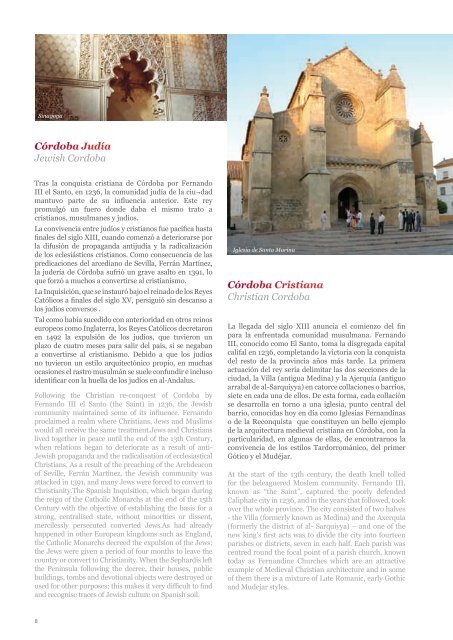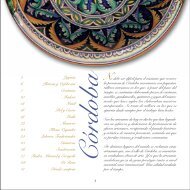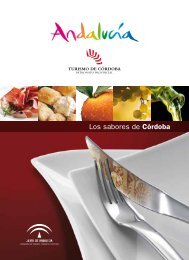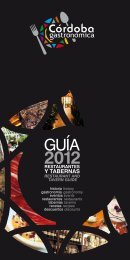You also want an ePaper? Increase the reach of your titles
YUMPU automatically turns print PDFs into web optimized ePapers that Google loves.
Sinagoga<br />
Córdoba Judía<br />
Jewish Cordoba<br />
Tras la conquista cristiana de Córdoba por Fernando<br />
III el Santo, en 1236, la comunidad judía de la ciu¬dad<br />
mantuvo parte de su influencia anterior. Este rey<br />
promulgó un fuero donde daba el mismo trato a<br />
cristianos, musulmanes y judíos.<br />
La convivencia entre judíos y cristianos fue pacífica hasta<br />
finales del siglo XIII, cuando comenzó a deteriorarse por<br />
la difusión de propaganda antijudía y la radicalización<br />
de los eclesiásticos cristianos. Como consecuencia de las<br />
predicaciones del arcediano de Sevilla, Ferrán Martínez,<br />
la judería de Córdoba sufrió un grave asalto en 1391, lo<br />
que forzó a muchos a convertirse al cristianismo.<br />
La Inquisición, que se instauró bajo el reinado de los Reyes<br />
Católicos a finales del siglo XV, persiguió sin descanso a<br />
los judíos conversos .<br />
Tal como había sucedido con anterioridad en otros reinos<br />
europeos como Inglaterra, los Reyes Católicos decretaron<br />
en 1492 la expulsión de los judíos, que tuvieron un<br />
plazo de cuatro meses para salir del país, si se negaban<br />
a convertirse al cristianismo. Debido a que los judíos<br />
no tuvieron un estilo arquitectónico propio, en muchas<br />
ocasiones el rastro musulmán se suele confundir e incluso<br />
identificar con la huella de los judíos en al-Andalus.<br />
Following the Christian re-conquest of Cordoba by<br />
Fernando III el Santo (the Saint) in 1236, the Jewish<br />
community maintained some of its influence. Fernando<br />
proclaimed a realm where Christians, Jews and Muslims<br />
would all receive the same treatment.Jews and Christians<br />
lived together in peace until the end of the 13th Century,<br />
when relations began to deteriorate as a result of anti-<br />
Jewish propaganda and the radicalisation of ecclesiastical<br />
Christians. As a result of the preaching of the Archdeacon<br />
of Seville, Ferrán Martínez, the Jewish community was<br />
attacked in 1391, and many Jews were forced to convert to<br />
Christianity.The Spanish Inquisition, which began during<br />
the reign of the Catholic Monarchs at the end of the 15th<br />
Century with the objective of establishing the basis for a<br />
strong, centralised state, without minorities or dissent,<br />
mercilessly persecuted converted Jews.As had already<br />
happened in other European kingdoms such as England,<br />
the Catholic Monarchs decreed the expulsion of the Jews;<br />
the Jews were given a period of four months to leave the<br />
country or convert to Christianity. When the Sephardis left<br />
the Peninsula following the decree, their houses, public<br />
buildings, tombs and devotional objects were destroyed or<br />
used for other purposes; this makes it very difficult to find<br />
and recognise traces of Jewish culture on Spanish soil.<br />
Iglesia de Santa Marina<br />
Córdoba Cristiana<br />
Christian Cordoba<br />
La llegada del siglo XIII anuncia el comienzo del fin<br />
para la enfrentada comunidad musulmana. Fernando<br />
III, conocido como El Santo, toma la disgregada capital<br />
califal en 1236, completando la victoria con la conquista<br />
del resto de la provincia años más tarde. La primera<br />
actuación del rey sería delimitar las dos secciones de la<br />
ciudad, la Villa (antigua Medina) y la Ajerquía (antiguo<br />
arrabal de al-Sarquiyya) en catorce collaciones o barrios,<br />
siete en cada una de ellos. De esta forma, cada collación<br />
se desarrolla en torno a una iglesia, punto central del<br />
barrio, conocidas hoy en día como Iglesias Fernandinas<br />
o de la Reconquista que constituyen un bello ejemplo<br />
de la arquitectura medieval cristiana en Córdoba, con la<br />
particularidad, en algunas de ellas, de encontrarnos la<br />
convivencia de los estilos Tardorrománico, del primer<br />
Gótico y el Mudéjar.<br />
At the start of the 13th century, the death knell tolled<br />
for the beleaguered Moslem community. Fernando III,<br />
known as “the Saint”, captured the poorly defended<br />
Caliphate city in 1236, and in the years that followed, took<br />
over the whole province. The city consisted of two halves<br />
- the Villa (formerly known as Medina) and the Axerquia<br />
(formerly the district of al- Sarquiyya) – and one of the<br />
new king’s first acts was to divide the city into fourteen<br />
parishes or districts, seven in each half. Each parish was<br />
centred round the focal point of a parish church, known<br />
today as Fernandine Churches which are an attractive<br />
example of Medieval Christian architecture and in some<br />
of them there is a mixture of Late Romanic, early Gothic<br />
and Mudejar styles.<br />
8







